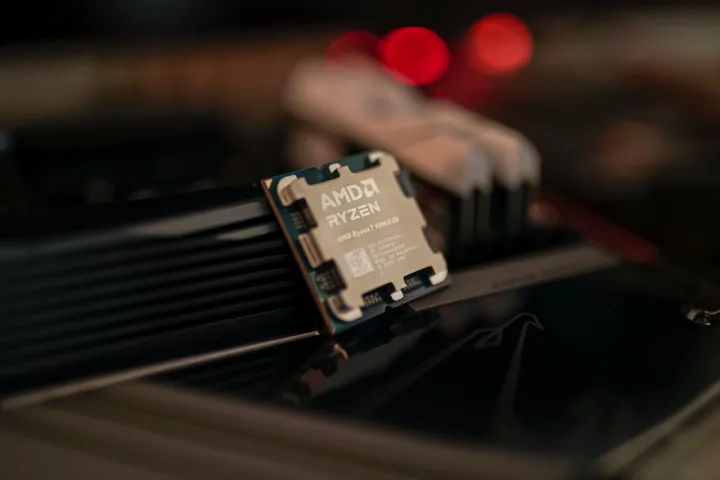I tested the Ryzen 7 9800X3D against the Core Ultra 9 285K. It’s not even close
AMD's new Ryzen 7 9800X3D punches far above its weight class, and my comparison to the Core Ultra 9 285K is proof of that.

AMD’s hotly anticipated Ryzen 7 9800X3D is finally here, and I’ll tell you right away that it’s one of the best processors you can buy. It introduces AMD’s next-gen 3D V-Cache tech, and it dominates in games. But there’s still plenty of competition coming from Intel.
The recent Core Ultra 9 285K offers more cores and higher speeds overall, and although it’s a flagship CPU, the price increase on the Ryzen 7 9800X3D means the two CPUs are closer than ever in price. I threw them on the test bench to see which CPU comes out ahead, and the race wasn’t nearly as tight as I thought it would be.
Specs and pricing
 Jacob Roach / Digital Trends
Jacob Roach / Digital TrendsThe Ryzen 7 9800X3D and Core Ultra 9 285K are in different performance classes, but they’re actually much closer in price than you might expect. A price increase on the Ryzen 7 9800X3D has brought it up to $479. Meanwhile, Intel has slowly reduced prices on its flagship over the last few generations. The Core Ultra 9 285K comes in at $629 right now, but prices should drop to around $589 in the near future. No doubt, the Ryzen 7 9800X3D is significantly cheaper, but the gap isn’t as large as it once was.
There’s a good reason why there’s still a gap. The Core Ultra 9 285K is a flagship, and it comes with all of the bells and whistles that justify that label. It’s a 24-core chip that comes with 24 threads. As opposed to CPUs like the Core i9-14900K, Intel chose to ditch hyper-threading on the Core Ultra 9 285K. Instead, it focused on individual core performance. That means that the Core Ultra 9 285K is closer to a true 24-core CPU, unlike previous Intel flagships, which mostly relied on eight performance cores.
| Core Ultra 9 285K | Ryzen 7 9800X3D | |
| Cores/Threads | 24/24 (8P+16E) | 8/16 |
| Boost clock speed | 5.7GHz | 5.2GHz |
| Base clock speed | 3.7GHz | 4.7GHz |
| Cache (L2 + L3) | 76MB | 104MB |
| TDP | 250W | 120W |
| Price | $629 | $479 |
The Ryzen 7 9800X3D is in a far different category. It’s only an eight-core processor, though it has access to simultaneous multi-threading (SMT), so you still get 16 threads. Core count isn’t the strong suit of this processor. It’s the 3D V-Cache tech that AMD is using. With this design, AMD is able to pack 104MB of cache onto the Ryzen 7 9800X3D, which stacks up against only 60MB of cache on the Core Ultra 9 285K.
In addition, the Ryzen 7 9800X3D uses AMD’s next-gen 3D V-Cache tech. With previous CPUs like the Ryzen 7 7800X3D, AMD would stack additional cache on top of the CPU die. Now, AMD puts the cache under the die. That gives the cores more direct access to cooling, allowing AMD to push clock speeds and unlock the processor fully for overclocking.
Outside of cores and cache, the Core Ultra 9 285K draws quite a bit more power than the Ryzen 7 9800X3D. It can climb up to 250 watts, while the Ryzen 7 9800X3D tops out at 120W — and it rarely ever reaches that mark. However, both CPUs are very efficient, so the gap isn’t as large as the specs would suggest.
Productivity performance
 Jacob Roach / Digital Trends
Jacob Roach / Digital TrendsJust based on the specs, you would assume the Core Ultra 9 285K mops the floor with the Ryzen 7 9800X3D, and there’s some truth to that. However, the gap between the two CPUs isn’t as large as you might suspect. Starting with the best showing for Intel, you can see Cinebench R24 above. The chart speaks for itself here. With a massive core advantage and higher clock speeds, the Core Ultra 9 285K comes out ahead in both single-core and multi-core performance.
 Jacob Roach / Digital Trends
Jacob Roach / Digital TrendsThe Core Ultra 9 285K has been labeled the Cinebench king for a reason, though. It performs oddly well in rendering applications like Cinebench. Even in Blender, which is another rendering application, you can see the Core Ultra 9 285K’s lead start to slip. It’s much faster than the Ryzen 7 9800X3D still, but it’s not offering two times the performance across the board.
 Jacob Roach / Digital Trends
Jacob Roach / Digital TrendsOutside of rendering, the Core Ultra 9 285K shockingly loses its grip on the performance crown. Handbrake shows that in action. The Core Ultra 9 285K completed the transcode 26% faster than the Ryzen 7 9800X3D, but that’s a hollow victory. Transcoding is a heavily threaded workload that should scale up to the massive core array on the Core Ultra 9 285K. Intel’s CPU is faster, no doubt, but it shouldn’t even be close.
 Jacob Roach / Digital Trends
Jacob Roach / Digital TrendsThese performance differences have big implications in real-world apps. If you look at Premiere Pro, for example, the Core Ultra 9 285K and Ryzen 7 9800X3D offer nearly identical performance. That’s bad for Intel. Premiere Pro is an app that can scale to more than eight cores, and the Core Ultra 9 285K just isn’t showing off those benefits.
 Jacob Roach / Digital Trends
Jacob Roach / Digital TrendsWorse, the Ryzen 7 9800X3D was actually faster than the Core Ultra 9 285K in Photoshop. It’s faster by a significant margin, too. Photoshop isn’t a very demanding app, and it doesn’t scale past eight cores. But it illustrates the inconsistent performance of the Core Ultra 9 285K, despite what its specs would suggest.
 Jacob Roach / Digital Trends
Jacob Roach / Digital TrendsElsewhere, the Ryzen 7 9800X3D leads in Y-Cruncher. This app calculates Pi, and although I don’t think most readers here are buying a CPU for that purpose, it offers a nice window into an advantage of the AMD chip. It supports AVX-512 instructions, which Y-Cruncher uses. Some AI applications, as well as PS3 emulation, use AVX-512 instructions. Despite that, the Core Ultra 9 285K doesn’t support these instructions. That leads to the Ryzen 7 9800X3D showing a sizable lead in Y-Cruncher despite its clear core disadvantage.
The Core Ultra 9 285K is a better choice than the Ryzen 7 9800X3D if you’re mainly concerned with productivity performance, but it’s still not a good choice. AMD’s Ryzen 9 9950X is your best bet for productivity. Keeping these two CPUs in isolation, however, the Ryzen 7 9800X3D actually comes out ahead, and that’s due to how it balances acceptable productivity performance with a massive gaming advantage.
Gaming performance
 Jacob Roach / Digital Trends
Jacob Roach / Digital TrendsI’ll let the chart above do most of the speaking here. It’s not even close when it comes to the gaming performance of the Ryzen 7 9800X3D and Core Ultra 9 285K. AMD’s CPU is universally faster in the 10 games I tested, and I can’t imagine there are many games — if any at all — where Intel shows a commanding lead. Even worse news for Intel is that these results aren’t solely on the back of AMD’s 3D V-Cache.
How can I tell? Look at games like Assassin’s Creed Mirage, Returnal, Red Dead Redemption 2, and Black Myth: Wukong. All of these games care way more about your graphics card than your processor, and the margins between the Ryzen 7 9800X3D and Core Ultra 9 285K are narrow. But AMD’s chip is still faster across the board. It’s not meaningfully faster, sure, but these titles showcase that the Ryzen 7 9800X3D is just a faster gaming CPU overall, 3D V-Cache or not.
In the titles where the additional cache shines, it’s a bloodbath. You see that very clearly in F2 2022 and Final Fantasy XIV Dawntrail, where the Ryzen 7 9800X3D is over 50 frames ahead. That’s a huge margin, and it largely comes down to the cache. Games like Cyberpunk 2077 see a big bump, too, which is surprising. Cyberpunk 2077 can scale well to a lot of cores, which the Core Ultra 9 285K offers, but the Ryzen 7 9800X3D still comes out ahead despite its modest core count.
It’s not a surprise that the Ryzen 7 9800X3D comes out ahead on gaming performance, but the margins are larger than I expected. Usually, I see a slight bump for a 3D V-Cache CPU over a flagship, but AMD absolutely crushes Intel here.
A decisive win
 Jacob Roach / Digital Trends
Jacob Roach / Digital TrendsBetween a lower price, much better gaming performance, and shockingly competent productivity performance, the Ryzen 7 9800X3D is the clear choice here. It comes with a price hike compared to the previous generation, but it’s still far cheaper than the Core Ultra 9 285K. It’s also based on the AM5 platform, so you can save even more money if you already have a Ryzen 7000 CPU that you want to upgrade from.
The Core Ultra 9 285K doesn’t really have a spot in the current landscape of CPUs. It’s an impressive chip, and certainly an interesting one, but it still doesn’t make a lot of sense to buy one — be it for gaming or productivity. It’s expensive and rarely maxes out on power, unless you just sit at your PC and run Cinebench all day.

 Kass
Kass 






























